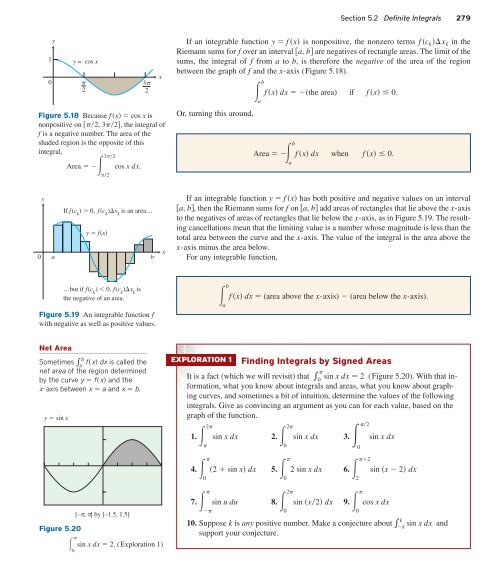FDWK_3ed_Ch05_pp262-319
FDWK_3ed_Ch05_pp262-319
FDWK_3ed_Ch05_pp262-319
Create successful ePaper yourself
Turn your PDF publications into a flip-book with our unique Google optimized e-Paper software.
Section 5.2 Definite Integrals 279<br />
1<br />
0<br />
y<br />
y = cos x<br />
<br />
2<br />
3<br />
2<br />
Figure 5.18 Because f x cos x is<br />
nonpositive on 2, 32, the integral of<br />
f is a negative number. The area of the<br />
shaded region is the opposite of this<br />
integral,<br />
32<br />
Area cos xdx.<br />
2<br />
x<br />
If an integrable function y f x is nonpositive, the nonzero terms f c k x k in the<br />
Riemann sums for f over an interval a, b are negatives of rectangle areas. The limit of the<br />
sums, the integral of f from a to b, is therefore the negative of the area of the region<br />
between the graph of f and the x-axis (Figure 5.18).<br />
b<br />
f x dx (the area) if f x 0.<br />
a<br />
Or, turning this around,<br />
Area b<br />
f x dx when f x 0.<br />
a<br />
0<br />
y<br />
a<br />
If f(c k ) 0, f(c k )x k is an area…<br />
y f(x)<br />
b<br />
x<br />
If an integrable function y f x has both positive and negative values on an interval<br />
a, b, then the Riemann sums for f on a, b add areas of rectangles that lie above the x-axis<br />
to the negatives of areas of rectangles that lie below the x-axis, as in Figure 5.19. The resulting<br />
cancellations mean that the limiting value is a number whose magnitude is less than the<br />
total area between the curve and the x-axis. The value of the integral is the area above the<br />
x-axis minus the area below.<br />
For any integrable function,<br />
…but if f(c k ) 0, f(c k )x k is<br />
the negative of an area.<br />
Figure 5.19 An integrable function f<br />
with negative as well as positive values.<br />
b<br />
f x dx (area above the x-axis) (area below the x-axis).<br />
a<br />
Net Area<br />
Sometimes b fx dx is called the<br />
a<br />
net area of the region determined<br />
by the curve y fx and the<br />
x-axis between x a and x b.<br />
y sin x<br />
[– , ] by [–1.5, 1.5]<br />
Figure 5.20<br />
<br />
sin xdx 2. (Exploration 1)<br />
0<br />
EXPLORATION 1<br />
Finding Integrals by Signed Areas<br />
It is a fact (which we will revisit) that sin xdx 2 (Figure 5.20). With that information,<br />
what you know about integrals and areas, what you know about graph-<br />
0<br />
ing curves, and sometimes a bit of intuition, determine the values of the following<br />
integrals. Give as convincing an argument as you can for each value, based on the<br />
graph of the function.<br />
1. 2<br />
sin xdx 2. 2<br />
2<br />
sin xdx 3. sin xdx<br />
<br />
0<br />
0<br />
4. <br />
2 sin x dx 5. <br />
2 sin xdx 6. 2<br />
sin x 2 dx<br />
0<br />
7. <br />
sin udu<br />
<br />
0<br />
8. 2<br />
sin x2 dx<br />
0<br />
2<br />
9. <br />
cos xdx<br />
10. Suppose k is any positive number. Make a conjecture about k sin xdx and<br />
k<br />
support your conjecture.<br />
0


